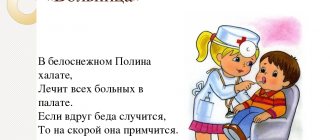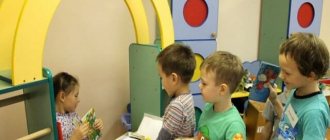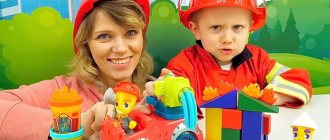The development of children of any age should be harmonious and affect the most important areas of personality formation: physical, mental, creative and social. Kindergarten students follow this course thanks to a special training program. Before taking an important step towards school, they still have a long way to go to acquire basic communication skills in different life situations. Role-playing games in the preparatory group of a kindergarten best meet the needs of children in social formation.
What are role-playing classes used in a child care facility?
It is believed that play is the main method of teaching preschoolers. Indeed, they are no longer children at home, but not yet first-graders; they intuitively strive to understand the world through a tool familiar to them. It is necessary to distinguish frivolous fun from educational activities aimed at developing children. Both the first and second should be present in the lives of children, and it is extremely important that the teacher knows how to combine and plan them correctly.
“Mothers and daughters”, “hospital” and many other familiar names for fun are examples of role-playing games in the preparatory group of a kindergarten. They are aimed at forming a healthy and stable social component in the overall development system of a preschooler. The baby is growing up, and on his way he encounters more and more new situations: a visit to the clinic, a visit, a meeting in a cafe. At the same time, communication often develops according to a certain scenario. A kind of rehearsal of the action helps the child prepare for new emotions and experiences.
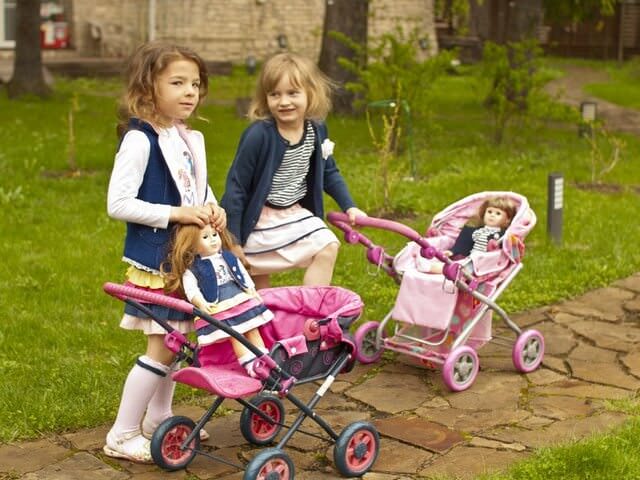
Organization of role-playing games in the preparatory group
Organization of continuous educational activities in the preparatory group on the topic: “Going to the dentist”
Author of the abstract: Svetlana Nikolaevna Baranova, teacher of MBDOU No. 93, Tomsk Priority educational area Social and communicative development: assimilation of norms and values accepted in society, development of communication and the child’s interactions with adults and peers; the formation of positive attitudes towards various types of work; In integration Speech development: Mastery of speech as a means of communication and culture Cognitive development: Development of imagination Physical development: Promote children’s acquisition of motor experience in various types of activities; formation of healthy lifestyle values, mastery of its elementary norms and rules of behavior; Targets: The child masters the basic cultural methods of activity; has a fairly good command of oral speech, can use speech to construct a speech utterance in a communication situation; the child has a developed imagination; masters basic movements, can control and control his movements; shows initiative and independence in play and communication, has a positive attitude towards different types of work; has basic knowledge about himself; is able to take into account the interests and feelings of others, can express his thoughts Equipment: bunny toy, modules, attributes for the educational game “Polyclinic”, cards for the educational activity “Helpful-Harmful” Children with a teacher enter the group.
Educator: Guys, I want to wish you all a good day, a good mood for the whole day.
And you, Sasha, would you like to wish all the guys good things? (the teacher listens to the children’s wishes one by one). The teacher draws attention to the toy bunny, whose face is bandaged and empty candy wrappers lie nearby.
Educator: Guys, who is this?
(children's answers)
.
What happened to him? ( the children come to the conclusion that the bunny has a toothache)
.
Guys, why do your teeth hurt? (children's answers)
.
What do you think caused the bunny's teeth to hurt? (children's answers)
.
So what, guys, should we do with the bunny? (go to the doctor)
.
What is the name of the doctor who treats teeth? ( dentist).
Where can we find a dentist?
(in the dental clinic
).
Of course, we have a long way to go to the clinic, so I propose organizing the clinic in a group. What do we need for this? (build a clinic)
.
Children with a teacher use scrap materials (tables, chairs, soft modules) to build a clinic, lay out the attributes for the playground game prepared in advance by the teacher.
Educator: Well, guys, it's time to go to the clinic.
What will we eat on? (children's answers).
Physical exercise “Car” To drive a car, we need to pump up the tires
(imitation of movement with the sound sh-sh-sh).
We’ll pour gasoline into the gas tank (
imitation of movement)
And we’ll go to the store
(“drive” around the room).
And then we’ll drink some water
(imitation of movement)
And we’ll arrive at the hospital.
(“travel” around the room). Children with a teacher and a bunny “arrive” at the hospital.
Educator: Guys, who are we missing at the clinic?
(doctor, nurse, receptionist)
.
How will we distribute the roles? ( according to the counting rhyme, at the request of the children). Children choose two dentists, a nurse, and a receptionist.
Who will the rest of the children be?
(by patients)
.
Children playing roles take their places.
Children-patients sit in line, go to the reception desk, where they receive a card and go to the dentist. The dentist prescribes medications. Educator: Guys, where can I buy medicine?
( at the pharmacy)
.
Who works in the pharmacy? (pharmacist)
.
Children and a teacher build a pharmacy and choose a pharmacist.
Children independently act out situations in the clinic. Educator: Well, guys, have you all been to the dentist?
Has everyone checked their teeth? What should you do to keep your teeth healthy? (children's answers)
.
Let's tell the bunny the rules of dental care. D/i “Helpful-harmful”. Educator: It’s time for us to return to the group and say goodbye to the bunny. ( Children say goodbye to the bunny).
“One, two, three, turn around, appear in the group again!”
Children and their teacher sit in a circle and discuss the game.
Educator: Guys, did you like our trip? What did you like most? Do you remember? What didn't you like? Did not work out?
We recommend watching:
Didactic game for preschoolers for the development of fine motor skills Synopsis of the plot-role-playing game “Zoo” in the middle group The plot-role-playing game of children for the older group. Let's go for a visit Project for organizing a role-playing game in a preparatory group
Similar articles:
DIY didactic toy. Step-by-step master class with photos
Do-it-yourself didactic games made from waste material
Do-it-yourself didactic game for preschoolers “In the world of animals”
Do-it-yourself didactic game for kindergarten on the topic “Sports”
Using didactic games in kindergarten classes
Growing and learning new things
Prepared theatrical activities using roles and plots allow the teacher to achieve a number of goals.
- Study and collect observations about the pupil’s temperament and social inclinations.
- Introduce the children to several options for the development of action in everyday situations, talk about the existence of communication norms and so-called templates.
- Teach preschoolers respect for rules and tolerance.
- To prepare students for their first independent steps in society, allowing them to try on different behavioral roles.
- Stimulate the development of speech and imagination.
- Encourage teamwork.
- Correct any deviations from generally accepted communication norms in a timely manner: stop aggression, excessive gestures, help with shyness, etc.
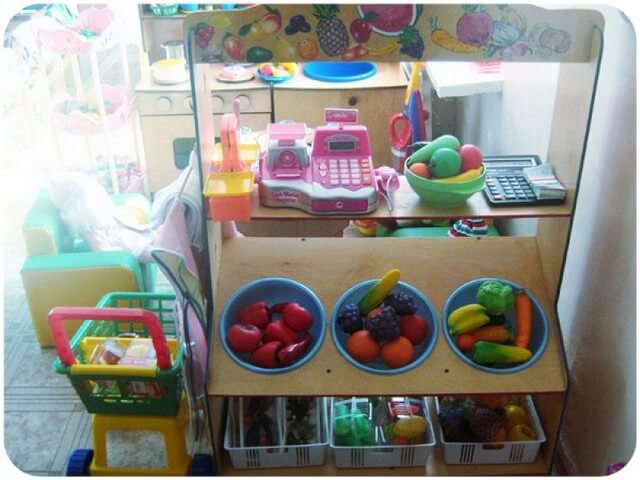
Card index of role-playing games for spiritual and moral education for preschoolers
— Game "Generous Gifts"Goal: developing the ability to perceive goodness, justice and generosity. Distribution of roles: One child - Fairy of Generosity. The rest of the children receive different letters and remember them.
Progress of the game:
Children spin around to the music. When the music stops, the children freeze.
The "Generosity Fairy" touches someone with her magic wand. At the same time, the child names his letter. The “Fairy of Generosity” must come up with what kind of generous gift she has prepared for a given letter. For example, she will give someone with the letter “Z” an umbrella so that he doesn’t get wet in the rain, or a bunny so that he can play with it. If the “Fairy of Generosity” cannot come up with a gift herself, those children whom she has already “revived” help her.
— Game “True Friends”
Goal: developing the idea of mutual assistance and friendliness.
Progress of the game:
Divide the room into two parts with chalk or ropes. One part is land, the other is sea. Children hold hands and walk in a circle to the music.
When the music stops, everyone stops. Those children from the circle who find themselves on “land” must save those who find themselves in the “sea”. To do this, children perform various tasks that the teacher offers them.
The task of the children is to save their children as quickly as possible.
— Game “How to take care”
Goal: developing ideas about goodness, love and care.
Progress of the game:
Children stand in a circle. The teacher goes around the circle and places different toy animals in the hands of the children, and then names one toy animal, for example, a cat. The one who has the cat in his hands goes to the middle of the circle and asks the children to take turns telling how to take care of the cat. The child in the center of the circle gives his toy to the one whose story he liked the most.
— Game “Only Good”
Goal: to develop in children an idea of goodness; development of oral speech: creative thinking, imagination.
Progress of the game:
The teacher, with a ball in his hands, stands in front of the children, asks them to line up, and then throws the ball to each of them. Children catch the ball only when the teacher pronounces some good quality (truthfulness, kindness, accuracy).
In this case, they take a step towards the teacher. If children accidentally “catch a bad quality” (intolerance, greed, anger), they take a step back. The one who reaches the teacher first wins. This person becomes the leader.
— Game “Favorite quality”
Goal: to develop in children an understanding of the phenomena of reality from the standpoint of moral and ethical standards.
Ask the children to sit in a circle and invite them to think about their favorite quality. Then, one by one, the children name their favorite quality.
If a certain quality is liked by the majority of children, that quality is invited to settle in the group. He is given a beautiful chair, which becomes the chair of kindness, caring, observation or courage. In the future, any child who wants this quality to grow in him can sit on a chair of one quality or another. Also, if one of the children behaves badly, cries, or does not listen well, the teacher invites him to sit on a chair of one quality or another. Children can choose a new quality every week and invite it to live in their group.
— Game “Beauty Ring”
Goal: assistance in the formation of the child’s personality, his social and moral relations with the outside world through the development of the best qualities.
Progress of the game:
Tell the children that you have a beauty ring. As soon as you point the ring at any person, all the most beautiful things in him immediately become visible. Children stand in a circle and extend their folded palms forward. The teacher discreetly places a ring in someone’s hands. Then the children shout in unison: “Ring, ring, go out onto the porch.” The person who receives the ring runs out to the middle of the circle. He should touch his friends with the ring and tell him what beautiful things he sees in them. The one who sees the most beauty in his friends receives a beauty ring as a gift.
— Game “Circle of Honesty”
Goal: formation of social and moral relationships with the outside world through the development of the best qualities - the child’s honesty.
Progress of the game:
Children are divided into two teams.
Members of one team stand in a circle and, holding hands, raise them up. This is the circle of honesty. The second team forms a chain, one after another, running in and out of the circle of honesty like a stream to the sound of cheerful music.
When the music stops, the children forming a circle of honesty lower their hands and do not let anyone out of the circle. Those who remain in the circle take turns talking about some honest deeds.
Then the teams change places.
— Game "Magic Wand"
Goal: to cultivate in children a sense of mutual assistance and cooperation, the development of coherent speech.
Progress of the game:
Children stand in a circle and take turns recalling a situation when they needed help.
For example: bad mood, toothache, offended someone, didn’t buy a new toy. The teacher has a beautiful magic wand in his hands.
When the first child talks about his problem, the teacher says: “Lifesaver, help! Help a friend out of trouble!” The child who knows how to help a friend in trouble raises his hand, and the teacher gives him a magic wand. This child touches his friend with a stick and tells him how he can help him.
If none of the children know how to help their friends, the teacher himself touches this or that person with a magic wand and tells the children how they can help a friend out of trouble.
— Game “Life in the Forest”
Goal: education of moral and volitional personality traits in children of senior preschool age.
Progress of the game:
Teacher (sits on the carpet, seating the children around him): Imagine that you find yourself in the forest and speak different languages. But you need to communicate with each other somehow. How to do it? How to ask about something, how to express your friendly attitude without saying a word? To ask a question, how are you doing, clap your palm on your friend’s palm (show). To answer that everything is fine, we tilt our head to his shoulder; we want to express friendship and love - we affectionately stroke the head (show). Ready?
Then we started. It’s early morning, the sun is out, you just woke up...
The teacher unfolds the further course of the game at random, making sure that the children do not talk to each other. Communication without words eliminates quarrels, disputes, contracts, etc.
— Game “Good Elves”
Goal: education of moral and volitional personality traits in children of senior preschool age.
Progress of the game:
Teacher (sits on the carpet, seating the children around him): - Once upon a time, people, fighting for survival, were forced to work day and night. Of course, they were very tired. The good elves took pity on them.
As night fell, they began to fly to people and, gently stroking them, lovingly lull them to sleep with kind words. And people fell asleep. And in the morning, full of strength, they set to work with renewed energy. Now we will play the roles of ancient people and good elves. Those who sit on my right hand will play the roles of these workers, and those on my left will play the roles of elves. Then we will switch roles. So, night came. Exhausted from fatigue, people continue to work, and kind elves fly in and lull them to sleep...
A wordless action ensues.
— Game “Chicks”
Goal: education of moral and volitional personality traits in children of senior preschool age.
Progress of the game:
Educator: - Do you know how chicks are born? The embryo first develops in the shell. After the allotted time, he breaks it with his small beak and crawls out. A big, bright, unknown world opens up to him, full of mysteries and surprises. Everything is new to him: flowers, grass, and shell fragments. After all, he had never seen all this. Shall we play chicks? Then we’ll squat down and start breaking the shell. Like this! (Show.) That's it! They smashed it! Now we’ll explore the world around us - let’s get to know each other, walk around the room, sniff the objects. But keep in mind that chicks cannot talk, they only squeak.
— Game “Ants”
Goal: education of moral and volitional personality traits in children of senior preschool age.
Progress of the game:
Teacher (seating the children around him).
“Have any of you ever seen an anthill in the forest, inside of which life is seething day and night? None of the ants sit idle, everyone is busy: some carry needles to strengthen their homes, some prepare dinner, some raise children. And so all spring and all summer. And in late autumn, when the cold sets in, the ants gather together to sleep in their warm house. They sleep so soundly that they are not afraid of snow, blizzards, or frosts. The anthill wakes up with the onset of spring, when the first warm rays of the sun begin to break through the thicket of needles. But before starting their usual working life, the ants throw a noble feast. I have this proposal: the role of ants on a joyful holiday day. Let's show how the ants greet each other, rejoicing at the arrival of spring, and how they talk about what they dreamed about all winter. Just don’t forget that ants can’t talk. Therefore, we will communicate using gestures.”
The teacher and children act out the story told through pantomime and actions, ending with a round dance and dancing.
— A variant of the folk game “One, two, three run!”
Goal: formation of strong-willed qualities and mastery of one’s behavior.
Features of the game: - the child must choose his own partner, thus getting the opportunity to express sympathy to one of his peers.
Description of the game and how to play it:
“Let's see which of you can run fast!” - the teacher addresses the children. He invites everyone to hold hands and form a nice, even circle. Children lower their hands and sit on the floor (if the game is played indoors) facing inside the circle. The teacher, being behind the circle, goes around him, saying:
- The fire is burning, the water is boiling, you will be washed today. I won't catch you! The children repeat the words after him. On the last word, the adult touches one of the children, asks him to stand up, turn to face him, and then says: “One, two, three - run!” The teacher shows in which direction you need to run around the circle in order to be the first to take the vacant seat. The teacher and the child run around the circle from different sides. The adult gives the child the opportunity to be the first to take an empty seat and again becomes the driver. He goes around the circle again and repeats the words, giving the children the opportunity to remember them and get used to the rules of the new game. Having chosen another child, the adult this time tries to be the first to take a place in the circle. Now the child becomes the driver and chooses his own competition partner. The winners are rewarded with applause. So, in turns, the children compete with each other.
Rules of the game.
1. Choose as a partner someone who has never run before.
2. Run in a circle in opposite directions.
3. The one who did not have time to take a place in the circle becomes the driver.
— The Fox and the Geese (Variant of the folk game)
Goal: to create a desire to help others.
Features of the game and its educational value:
- contributes to the development of organization in children, the ability to manage their behavior in a team.
— The child’s task is not only to avoid danger himself, but also to help out the one who was caught by the catcher (fox).
Description of the game and methods of its implementation.
The whole group takes part in the game. A child is chosen to play the role of a fox who will catch geese. The rest of the children portray geese, whose owner is the teacher.
An adult draws two lines on the ground at a distance of 25 - 30 steps. Behind one of them is the house of the owner and the geese, and behind the other is a meadow where geese graze. The circle represents the fox's hole. The game begins.
The owner escorts the geese to the meadow. For some time the birds walk freely, nibbling grass. At the call of the owner, who is in the house, the geese line up at the line (the border of the meadow), and the following dialogue takes place between them:
Master. Geese-geese!
Geese. Ga-ga-ga.
Master. Do you want to eat?
Geese. Yes Yes Yes!
Master. Well, fly!
The last phrase is a signal: the geese run to their owner, and the fox catches them.
When the fox has molested two or three geese (touches them with her hand), she takes them to her hole. The owner counts the geese, notes which ones are missing, and asks the children to help the goslings in trouble. All participants in the game, together with the teacher, approach the fox hole.
All. Fox-fox, give back our goslings!
Fox. Will not give it back!
All. Then we ourselves will take them away from you!
The teacher invites the children to stand behind him “in single file” and tightly grab each other by the waist. "Cling to me!" - says the owner. He approaches the fox, takes her by the hands and says, turning to the geese: “Hold on tight. Pull - pull. Wow! All participants in the game, resting their feet and holding each other, move their body back to the words of the teacher “pull” (two or three times).
As soon as the fox, under pressure from this chain, takes the first step forward, the caught geese run out of the hole and return home. Then a new fox is chosen and the game starts all over again.
Rules of the game:
1. The geese run home, and the fox is allowed to catch them only after the owner says, “Well, fly.”
2. The fox should not grab the geese, it is enough to just nag the running child. The caught goose remains in place, and the fox takes it to its hole.
3. All participants in the game go to the rescue of the caught geese.
At the end of the game the result is summed up. The teacher explains to the kids that they helped out their friends because they acted together, all together.
Used Books:
1. Zaporozhets A.V. The World of Childhood. Preschooler. M.: Pedagogika, 1987. 416 p.
2. Loginova V.I., Samorukova P.G. Preschool pedagogy. M.: Education, 1991. 63 p.
3. Podlasy I. P. Pedagogy. M.: Humanit, 2000. 256 p.
4. Friedman L. M. Psychology of children and adolescents: a reference book for teachers and educators. M.: Institute of Psychotherapy, 2005. 480 p.
5. Alyabyeva E. A. Moral and ethical conversations and games with preschoolers. M.: TC Sfera, 2003. 128 p.
6. Boguslavskaya Z. M., Smirnova E. O. "The role of play in the moral development of a child." M.: “Enlightenment”, 1991.
Types of plots for theatrical preschool activities
With the help of story plays, kindergarten students acquire basic knowledge about their future life. They can be called a “school of life.” So, educators select stories that are close to the understanding of a 4-5 year old child.
- Everyday home stories cover the following topics: “family”, “birthday celebration”, etc. They are associated with the everyday life of a preschooler and an adult, and are designed to model comfortable relationships between close people - parents, relatives, brothers and sisters.
- The plots of the scenes “going to the library”, “school”, “examination at the clinic” are associated with interaction with surrounding people performing their duties at work. For example, by acting out the “hospital” scene, the student not only acquires knowledge of how to behave during an examination by a doctor, but also observes his professional behavior, gains knowledge about the main attributes of doctors: a white coat, a “listener,” etc. By acting out the scene “hair salon”, girls can try themselves in the role of a beautiful fairy who works miracles. The “bank” plot will allow children to get acquainted with the world of finance, the working atmosphere, and will show the essence of the work of a cashier and operator. "Theater" is full of interesting roles both on stage and behind the scenes. This is how children acquire knowledge about basic professions.
- Stories inspired by cartoon films familiar to all students. Among the popular stories are “Well, wait a minute!”, “Masha and the Bear” and others.
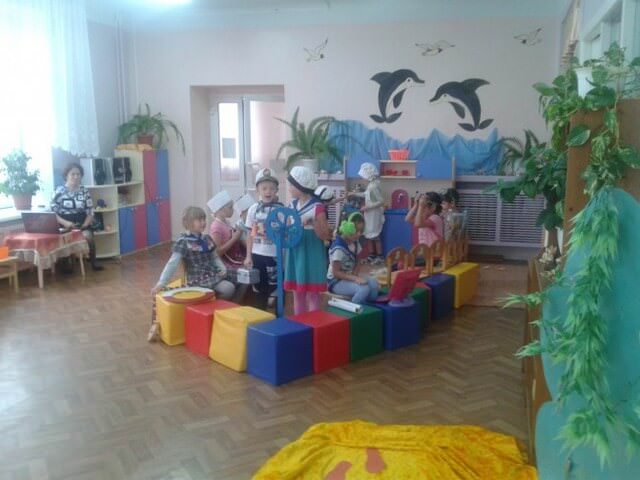
The practice of many kindergartens includes maintaining special cards of role-playing games. They represent an event plan detailing:
- necessary equipment: books, cutlery, equipment;
- interior space: background, furniture, toys;
- costumes of heroes, clothing marking their profession: a chef’s hat, a special apron for a hairdresser, etc.
The use of cards is aimed at preliminary thorough preparation for the event by both educators and preschoolers. Close acquaintance with the students and already accumulated observations regarding their preferences and tastes allow the organizer to choose the most suitable topics for a particular year of study.
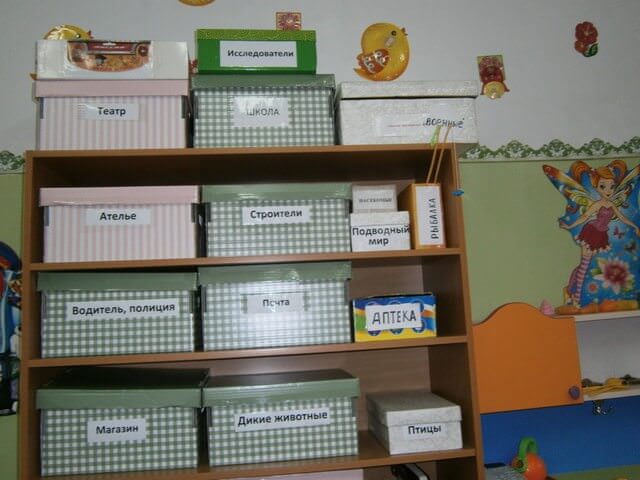
“Organization of role-playing games in the preparatory group of a kindergarten” consultation on the topic
“Organization of role-playing games in the preparatory group of a kindergarten”
General characteristics of the role-playing game
Role-playing game is the main type of play for a preschool child. In characterizing it, I would like to emphasize that this game is the most spontaneous manifestation of a child and at the same time it is based on the interaction of a child with adults. It has the main features of the game: emotional richness and enthusiasm of children, independence, activity, creativity.
Role-playing game by its nature is a reflective activity. The main source that fuels a child’s play is the world around him, the life and activities of adults and peers.
The basis of the role-playing game is an imaginary or imaginary situation, which consists in the fact that the child takes on the role of an adult and performs it in a play environment created by him.
Children's independence in role-playing games is one of its characteristic features. Children themselves choose the theme of the game, determine the lines of its development, decide how they will reveal the roles, where the game will unfold, etc. Each child is free to choose the means of embodying the image. At the same time, nothing is impossible: you can, sitting in a chair - a “rocket”, find yourself on the Moon, using a stick - a “scalpel” - to perform an operation. Such freedom in realizing the concept of the game and flights of fantasy allow the preschooler to independently engage in those areas of human activity that in real life will not be available to him for a long time.
By uniting in a role-playing game, children choose partners of their own free will, set the game rules themselves, monitor their implementation, and regulate relationships.
But the most important thing is that in the game the child embodies his view, his idea, his attitude towards the event that he is acting out. Thus, in a role-playing game, the child’s knowledge and impressions do not remain unchanged: they are replenished and refined, qualitatively changed, transformed. This makes the game a form of practical knowledge of the surrounding reality.
Like any creative activity, role-playing play is emotionally rich and brings joy and pleasure to every child by its very process.
A role-playing game has the following structural components: plot, content, role.
The main component of a role-playing game is the plot; without it, there is no role-playing game itself. The plot of the game is the sphere of reality that is reproduced by children. The plot is a child’s reflection of certain actions, events, relationships from the life and activities of those around him. At the same time, his game actions (turning the steering wheel of a car, preparing dinner, teaching students to draw, etc.) are one of the main means of realizing the plot.
The plots of the games are varied. Conventionally, they are divided into household (family games, kindergarten), industrial, reflecting the professional work of people (games to the hospital, store, etc.), public (games to celebrate the city’s birthday, to the library, school, etc. .).
Throughout the history of mankind, the plots of children's games change because they depend on the era, economic characteristics, cultural, geographical, and natural conditions. Thus, the games of children of the peoples of the North reflect the hunting of seals, walruses, and the work of reindeer herders. Children living in coastal regions play shipbuilders, work in the port, and greet tourists.
But, in addition, in every era there were extreme events that significantly affected people's lives and evoked an emotional response in children and adults. Such events always gave rise to new stories for children's games. For many years, the children of our country played in the Great Patriotic War (battles, bombings, partisans, etc.), after Yu. Gagarin’s flight into space, children in many countries around the world began to play in the exploration of interplanetary space (building rockets, going to Mars, Moon, working on the Mir space station).
In the history of mankind, there are also “eternal” plots of children’s games that seem to connect generations of people: games of family, school, hospital, etc. Naturally, these plots in the games of children of different times and peoples differ in their content, just as they differ in life itself .
The content of the game is what is reproduced by the child as a central and characteristic moment of activity and relationships between adults in their everyday, work, and social activities.
In terms of content, the games of children of primary preschool age differ from the games of older children. These differences are associated with the relative limitations of experience, features of the development of imagination, thinking, and speech.
Children of senior preschool age thoughtfully approach the choice of plot, discuss it in advance, and plan the development of the content at an elementary level. New stories appear that are inspired by impressions gleaned outside the preschool: based on animated series, books read at home, stories from adults, etc. The generalization of game situations continues; in addition to conditional and symbolic actions, children actively use verbal comments (“Everyone seems to have slept - and we’re going straight to the hall for the holiday!”; “Let’s do this: we’ve already arrived in Africa!”). These speech comments are a verbal replacement of any events. Children resort to them so as not to violate the logic of the unfolding of the game’s content.
The content of the role-playing game is embodied by the child through the role he takes on. A role is a means of realizing the plot and the main component of a role-playing game.
For a child, a role is his playing position: he identifies himself with a character in the plot and acts in accordance with his ideas about this character. Every role contains its own rules of behavior, taken by the child from the surrounding life, borrowed from relationships in the adult world. So, the mother takes care of the children, prepares food for them, puts them to bed; The teacher speaks loudly and clearly, is strict and demands attention in her lessons.
Submission of the child to the rules of role-playing behavior is the most important element of role-playing play. Deviation from the rules by anyone or those playing causes protests from the playing partners. That is, for preschoolers, a role is an example of how to act. Based on this sample, the child evaluates the behavior of the participants in the game, and then his own.
The role appears in the game at the border between early and preschool age. In the third year of life, the child’s emancipation from the adult is observed. At the same time, the preschooler’s desire to act independently, but like an adult, grows. Then, while playing, the baby begins to perform individual actions characteristic of an adult (puts the doll to sleep, like a mother), although he does not call himself by the adult’s name. These are the first beginnings of the role. One more sign should be included among them: the child “voices” the toy, speaking on its behalf.
Throughout preschool childhood, the development of role in role-playing games occurs from the performance of role-playing actions to role-images. For younger preschoolers, everyday activities predominate: cooking, bathing, washing, driving, etc. Then role designations associated with certain actions appear: I am a mother, I am a driver, I am a doctor.
The role taken gives a certain direction and meaning to actions with objects: the mother chooses toys or objects for play that are necessary for preparing dinner, bathing the child; the doctor selects a pencil thermometer for treatment, tears up pieces of paper for mustard plasters, pours out imaginary medicine, etc. Thus, when playing a role, children of primary school age use toys, real objects (spoon, basin, etc.), as well as substitute objects (a pencil or stick becomes a knife, spoon, thermometer, syringe, etc. in the game).
In older preschool age, the meaning of the game lies in the typical relationships of the person whose role is played by the child with other persons whose roles are taken on by other children. In games, role-playing dialogues appear, with the help of which the relationships between characters are expressed and game interaction is established.
For the quality of role performance, the child’s attitude towards it is important. Therefore, it should be borne in mind that older preschoolers are reluctant to perform roles that, in their opinion, do not correspond to their gender. Thus, boys refuse to play the role of a teacher, the head of a preschool institution, and in the game of school they agree to be only a physical education teacher.
When performing a role, the child takes into account not so much the external logic, the sequence of actions, but the meaning of social relations.
Thus, the main structural components of a creative role-playing game are the plot, which is the child’s reflection of the reality around him; content is what is reproduced by the child as a central and characteristic moment of activity and relationships between adults in their activities, and the development and complication of which is carried out in the following directions:
strengthening the purposefulness, and therefore the consistency and coherence of the depicted;
a gradual transition from an expanded game situation to a collapsed one, generalization of what is depicted in the game (the use of conditional and symbolic actions, verbal substitutions);
role is a means of realizing the plot.
Games in the preparatory group acquire a social character in children. The child seems to try on different social roles, copies adults, and gains communication experience. This form of communication is a real school of life for a child.
Plot role-playing games become a kind of mirror of the relationships between surrounding adults. On the other hand, such a game is a convenient form of correcting a child’s behavior and attitude in any situation. A thematic card index of games will help the teacher competently plan this form of work throughout the whole year.
Organization of the game
Thematic role-playing game in the preparatory group requires careful preparation. Depending on the goals and objectives, the teacher thinks through not only the theme, plot, selects equipment, but also takes into account the psychological compatibility of children expected to play certain roles.
The game design provides for a method for selecting participants, ways to resolve possible conflicts, and ways to reconcile conflicting children. Most often, conflicts arise in the group due to the distribution of roles, due to the reluctance to accept into the game someone who previously could not cope with his role. The teacher’s task is to convince the participant of his abilities, teach him to be tolerant and tolerant, and help develop a sense of mutual assistance and support. In the preparatory group, the teacher rarely chooses a role. The teacher asks leading questions, gives advice, guides, and helps to understand the situation.
Goals and objectives
When developing a plot-role-playing game project, it is necessary to clearly set a goal that regulates the algorithm of actions plot-wise and psychologically.
The main tasks of the game form of work in the preparatory group: the formation of awareness of different emotional states; development of communication skills with adults and peers; expanding ideas about professions; deepening knowledge of ethical behavior; formation of ideas about school, regime; development of creative imagination; fostering independence, goodwill, and tolerance.
Inventory
The card index of plot-role-playing games includes a careful selection of gaming tools. When drawing up a project, the teacher thinks through the game equipment, which would allow the child to show imagination, creative imagination, and resourcefulness. Make wide use of toy imitations of real household items: dishes, tools, household appliances, etc. Be sure to use toys that personify certain characters: dolls, animals.
Wardrobe elements or professional items are important: a doctor's coat, a teacher's pointer, a waiter's apron, a chef's cap, etc. The interior of the playing space is created with the help of toys - markers: a toy tent, kitchen furniture, a children's board, a model of a ship, etc. All types of equipment help children immerse themselves in the world of play, form ideas about the use of certain objects and their purpose.
Getting ready for school
In the preparatory group, children undergo a course of psychological, intellectual and physical preparation for school life. In the minds of many children, school already exists as a place for lessons, bells, and homework. Sometimes a frightening school image takes shape in a child’s imagination.
The card file offers the “School” project, which includes plot-based role-playing games that adapt the child to the system of school relationships. These games will help you learn what a lesson is, how to address a teacher, how to assemble a backpack yourself, and what recess is. Children get the opportunity to play the role of teacher and student.
The “School” project may include a tour of a school classroom, reading stories about first-graders, and learning songs and poems about first-graders. All this gradually creates a positive expectation of serious life changes and creates a feeling of self-confidence.
Raising a Reader
In the modern world, the role of the book is noticeably lost. Unfortunately, even the traditional reading of fairy tales to children in many families has been replaced by watching cartoons.
The library is not the most popular place among young parents. However, the role of books cannot be overestimated in the development and upbringing of children. The book remains the basis of school education.
The “Library” project is designed to develop children’s interest in books, develop the need to read, the ability to carefully handle books, and give an idea of the librarian profession. Before the game you need to take the children on an excursion. There, the children will see and understand what a library is, who a librarian is, sit in the reading room, and get acquainted with forms and catalogs. These impressions are reinforced by the Library game. Children act out an appeal to the librarian, learn to “treat” books, and make bookmarks for them.
The library will help you learn about the variety of books; the children talk about their favorite book. The Library game will teach you how to carefully stack books on shelves and carefully search for the book you need.
The plot-role-playing game “Library” develops a culture of behavior, teaches polite treatment and calm communication. The “Library” project may include game programs “Literary Living Room”, “Visiting a Fairy Tale” with dramatization of fragments and a story about the author.
My family
The card index of plot-role-playing games is always presented in a variety of ways in the “Family” theme. For every child, the family is a model of the whole world. The relationship between parents and children, communication with grandparents form a model of relationships with other people.
The “Family” project includes role-playing games: “Daughters - Mothers”; "Family dinner"; “Visiting grandma”; "Mom got sick"; "Little brother"; "Day off"; “Mom’s helpers,” etc. In preparation for the game, you can invite children to talk about their families and holidays in the house. Reading stories and poems to the family is recommended.
Let's go shopping
The “Shop” project is aimed at developing in children, through plot-role-playing games, the social role of seller – buyer. Before starting the game, children can be asked what store they go to with their parents, what they sell there, and what adults ask the seller about. The children get acquainted with the words “buyer”, “seller”, “product”, “counter”, “scales”, “department”, “showcase”, “change”, “receipt”, “packaging”.
The game “Shop” requires adherence to a culture of communication and knowledge of polite words. To begin with, you can only play a grocery store or a bookstore. Then it will be interesting to organize a whole supermarket, where children will visit different departments.
Pay attention to the children’s ability to correctly name a product, describe it, find differences, clearly pronounce a request, and use learned words - terms. A café may open here where customers can relax.
In the hospital
The “Hospital” project is aimed at introducing people to medical professions, developing the need to lead a healthy lifestyle and observe the rules of hygiene.
These role-playing games are good to carry out during preventive measures against colds and infectious diseases. During the game, the children use their own experience of communicating with health workers. Children expand their vocabulary with medical terms: doctor, doctor, nurse, patient, clinic, card, certificate, temperature, syringe, phonendoscope, stretcher, thermometer, heating pad, iodine, brilliant green, surgeon, ambulance.
The game “Hospital” gives each child the opportunity to play the role of a doctor, nurse, patient, or parent of a sick child. Situations of an appointment at a doctor's office and a call to a doctor's home are played out. You can set the scene for the ambulance call. In such gaming situations, it is appropriate to analyze the causes of diseases: hypothermia, tasting snow, swallowing small objects, injuries due to overindulgence.
Service sector
Thematic role-playing games “Cafe”, “Hairdresser”, “Atelier”, “Post Office” can be organized as separate projects or combined with the projects “Family” and “Shop”.
The purpose of these games is to form ideas about professions in the service sector, develop a culture of behavior in public places, and cultivate respect and interest in work. It should be taken into account that children are rarely in the studio, so it will be difficult for them to independently develop the plot of the game. “Cafe” In the game “Cafe” the guys take turns playing visitors, waiters, confectioners, and administrator. Children learn to place an order and serve customers politely. While playing in a cafe, children get acquainted with the culture of eating: how to properly eat cake, ice cream, and fruit. Family or friends can come to the cafe. Visitors may be dolls. The cafe waiter should kindly talk about the menu and offer something tasty. You can play out a birthday celebration in a cafe. One of the game situations could be inviting the chef of a cafe and expressing gratitude to him. A cafe may have a cloakroom where visitors will hand in their things, take a number, and when leaving they will get their things back. For the next game, invite the children to draw a menu, come up with a name for their cafe, and think about what they liked about this cafe.
Studio
Children usually know almost nothing about the work of an atelier. The Atelier project must begin with an acquaintance with this service sector, with professions in the atelier, with the names of fabrics, accessories, and clothing. Children will learn about embroidery threads, knitting, and appliqué. The child must be able to describe a thing, its color, purpose. Children can play in the doll studio. Young fashion designers can draw new clothes for their favorite dolls. The Atelier project can even include fashion shows, where the role of the viewer also needs to be played. You can bring your favorite animal to the studio and order warm clothes for it. The game "Atelier" develops imagination, creative imagination, shapes taste and sense of style. Offer to use your imagination and come up with a new thing for the doll yourself in your own studio.
Salon
When implementing the “Hairdressing Salon” project, the teacher invites children to play the role of hairdressers and visitors. You can act out a scene with a crying child - a doll, who needs to be persuaded to get a haircut.
The hairdressing game teaches polite manners, the ability to describe a hairstyle, name the color of nail polish, and indicate the length of hair. It is interesting to organize a hairdresser for pets. Clients may be their favorite toy animals.
The “Mail” project introduces children to the work of postmen and teaches them how to send letters and parcels. Invite children to draw holiday cards and post them in the Mailbox. Then the postman will distribute the messages. Before the New Year, children can write letters to Santa Claus. Find out how the envelope is sealed and a stamp is affixed. It’s interesting to play with sending and receiving a package from your grandmother. The post office will help you pack everything and deliver it to the recipient.
Theater
The plot-role-playing game “Theater” allows children to learn that theater is a whole world of different professions. The guys buy a ticket, present it at the control, hand over their things to the cloakroom, and go into the auditorium. And behind the scenes the theater lives a big life: the actor is helped to prepare for the performance by the make-up artist and costume designer, and the director directs his performance. Theater does not exist without an orchestra and conductor. Small playful fragments of the “Theatre” project are gradually forming into a general idea of theatrical life. Children talk about their trip to the theater with their parents. Theater is impossible without staging fairy tale fragments or poems. The teacher talks about different theater genres. An interesting game is puppet theater, where children can try themselves as puppeteers.
Role-playing games are a harmonious way of raising, educating and developing children. They provide the opportunity for psychological correction. Such games bring children together and teach cooperation and friendship.
School years are wonderful
Among the most popular topics for role-playing games in the preparatory group is school. Kindergarten students often focus on older children and try to adopt their behavior patterns. So, a preschooler is already a bit of a first-grader at heart and strives to become one. His future role excites him and even frightens him a little with the unknown. Proper organization of the lesson will allow participants to feel confident in their next role and understand the idea of the relationship between student and teacher.
Preparatory group. Senior preschool age. Children 6-7 years old
Scenario of the role-playing game “Rescue operation at the North Pole” (senior preschool age) Purpose: To continue to maintain children’s interest in the role-playing game , independently display the plot , distribute roles among themselves. Cultivate a kind attitude towards animals. Objectives: Educational: To cultivate moral feelings expressed in empathy for animals….
Thematic role-playing game “Pharmacy” for children of the preparatory group Summary of the game-activity for children of the preparatory group “ Thematic role-playing game “Pharmacy”
.
Goal: enriching children's play stories by accumulating knowledge on the topic and replenishing the play environment in the preschool group. Objectives: 1. Deepen children’s knowledge about the professions of pharmacy workers (pharmacist,…
Preparing for the game "School"
The school environment includes all student paraphernalia: blackboard, desks, rulers, pens, pencils, notebooks, backpacks, pointer and, of course, the school bell. The selection of costumes may be limited to imitation business clothes for teachers and white bows for girl students.
To prepare for the game, it is advisable to visit one of the schools with a group (with the permission of the director) and observe the events in the classrooms, in the corridors during recess, in the cafeteria. You can supplement the acquired knowledge by reading books about school and listening to relevant songs (“It’s fun to walk through the open spaces together,” “Wonderful school years,” etc.).
As a plot, the teacher can choose a number of small scenes in various lessons: Russian language, mathematics, physical education. The bell means the end of one scene and the transition to the next (after a break, of course). It is important to maintain the sequence of dialogues, to give each participant the opportunity to play the role calmly and fully.
Reading is the best learning
A logical continuation of the school theme will be the role-playing game “Library”. Like the previous option, in the preparatory group of the kindergarten it is greeted with great enthusiasm, especially if the preparation for it includes a visit to the House of Books.

The lesson is designed to develop in students an interest in books and a caring attitude towards them, as well as to introduce children to the profession of a librarian.
Before playing the game "Library"
A visit to the Palace of Books will be an exciting event for children. Most city libraries organize group visits and answer questions from those interested: how to care for books so that they last a long time, how to keep a large number of books in a logical order, and how to quickly find the one you need? Teachers supplement this information with the basic rules of reading books: they remind you of the prohibition of tearing and crushing books, drawing in them, and teach you to turn the pages correctly. It is important to give children the opportunity to examine the work of all departments of the library: the living room, subscription, reading room and restoration workshop.
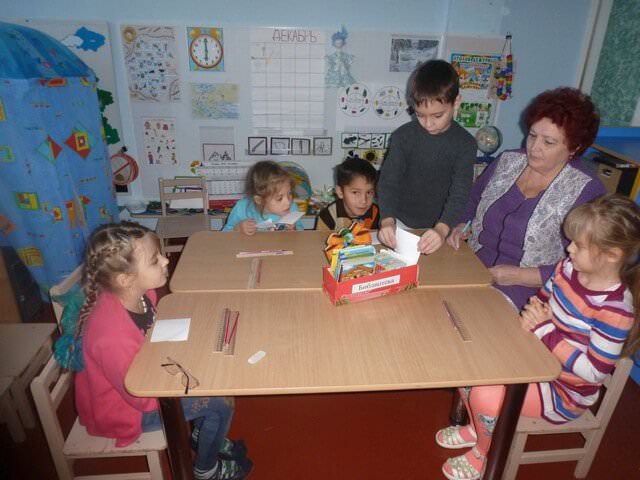
Of course, after the inspiration received, each student himself knows what equipment is needed for the stage - books. You can put 2-3 shelves and fill them with books of various types. You should also create something like a subscription and a card index. Dialogues can be played out between a librarian and a group of students looking for books to work on at home. Pay attention to the main rule of behavior in the library - maintaining silence. Switch to whispering dialogues with your children: this will not only immerse you in the atmosphere of the library, but will also serve as a useful exercise for children’s articulation apparatus.
Organization of role-playing games in the context of the implementation of the Federal State Educational Standard
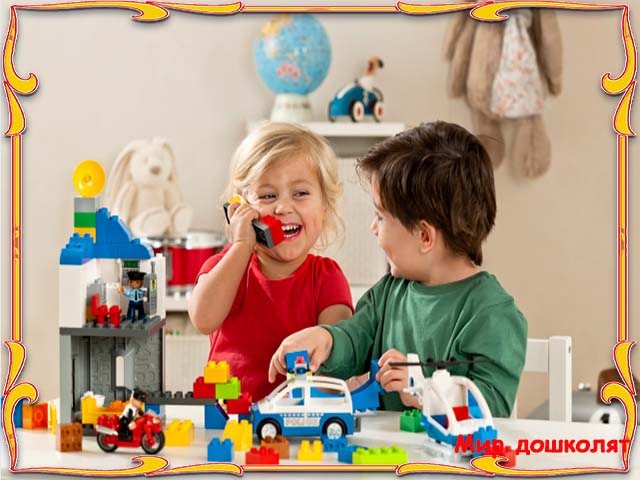
Play is important in a child’s life; it has the same meaning as activity, work, or service for an adult. What a child is like at play, so in many ways he will be at work when he grows up. Therefore, the education of a future leader occurs, first of all, in play. Makarenko A. S.
Preschool childhood is the most important period of personality development. During these years, the child acquires initial knowledge about the life around him, he develops certain attitudes towards people, towards work, develops skills and habits of correct behavior, and develops a character.
The main activity of preschool children is play. Play at this age is a special activity that accompanies a person throughout his life. The game develops the child’s spiritual and physical strength; his attention, memory, imagination, discipline, dexterity, all aspects of his personality are formed and developed, significant changes occur in his psyche, which prepare the transition to a new, higher stage of development. In the studies of L. S. Vygotsky, A. N. Leontyev, A. V. Zaporozhets, D. B. Elkonin, play is defined as a leading type of activity that does not arise through spontaneous maturation, but is formed under the influence of social conditions of life and upbringing. The game creates favorable conditions for the formation of the ability to perform actions in the mental plane, and carries out psychological replacements of real objects. A special place in the activities of a preschooler is occupied by games that are created by the children themselves, these are creative or role-playing games. In them, children reproduce in roles everything that they see around them in the life and activities of adults.
The main points of the methodology for using role-playing games:
1. Game selection. The choice of game is necessarily determined by the specific educational task.
Pedagogical development of a game plan. The initial stage of the pedagogical design of a long game is the outline of its plot, the definition of game roles and filling them with specific content.
Introducing children to the game plan. The game plan that the teacher develops can be offered to children in the senior and preparatory groups.
Creating an imaginary situation. This is the most important basis for starting a role-playing game. It is very important for a teacher to help a child enter a gaming situation so that the game captures his imagination and brings him the joy of creativity.
Distribution of roles. When distributing roles, the teacher strives to satisfy the play needs of children, that is, he gives everyone the desired role, suggests a sequence of playing roles of varying degrees of activity, and looks for opportunities to establish the child’s position in the team through a play role.
Start of the game. In order to evoke a positive perception of long-term play in children, the teacher needs to take care of the beginning of the play action in which an imaginary situation would immediately arise.
Saving the game situation.
There are some conditions for maintaining persistent interest in children:
1) the adult organizer of the game is obliged to set the tone for how children play and use conventional terminology; 2) whenever possible, the teacher should try to play up any activity of the children’s group; 3) the teacher must carry out all measures of pedagogical influence on children in a playful manner, without destroying the imaginary situation; 4) during a long-term role-playing game, it is advisable to include extensive creative games; 5) you can organize collective competitions between small groups of the playing team.
Ending the game. It is important to outline the proposed ending to maintain a strong emotional state and desire.
Thus, it should be remembered that planning is subject to the activities of the teacher in developing the game and its management, and not to the activities of the children in the game. With the adoption of the Federal State Educational Standard, play becomes the content and form of organization of life. Game moments, situations and techniques are included in all types of children's activities and communication between the teacher and preschoolers, that is, we, teachers, must saturate life as much as possible with play and emotional events. In the game, all educational areas are interconnected. The most effective form with the implementation of the Federal State Educational Standard is the form of thematic weeks. In order to enrich children's knowledge on the topic of role-playing and director's games, educational activities should be carried out, including conversations, a teacher's story, examination of illustrative material, and discussion of video presentations. It is very important to select fiction that contains dialogue between characters using professional vocabulary. A variety of productive activities (independent and joint with the teacher) should also be carried out in the production of attributes, game modules, and layouts on the theme of the game. This form of activity activates dialogical speech and communication skills in the development of creativity. For a more successful game, it is advisable to plan episodes (blocks - plots) of the planned game, where the teacher either acts as an equal partner or as a leader, demonstrating more complex methods of gaming activity. Directed and role-playing games are long-term games, so when organizing the lives of children in age groups, you need to consider:
- the conduct of routine moments, walks and educational activities in physical education does not change;
- GCD and the second half of the day are reserved for gaming and thematically related productive, educational, research, communicative activities, reading relevant fiction;
- educational tasks at all stages must be solved in the joint activities of the teacher with children and in the independent activities of preschoolers.
Constantly expanding children's knowledge about life around them and enriching their impressions is one of the most important conditions for the development of full-fledged play in a particular group of children. Important for the development of role-playing games is the pedagogically appropriate selection of toys and game materials, which creates the “material basis” of the game and ensures the development of the game as an activity. The selection of toys should be carried out in accordance with the main theme of children's games in a given age group, taking into account the immediate zone of their development. When selecting toys, the teacher should take into account the nature of the requirements that children of this age place on a toy. The availability of ready-made kits consisting of the most necessary toys allows children to quickly develop the game and select additional gaming materials. Such a set of toys should be compiled by the teacher together with the children as the game develops, and not be given only in finished form. Children, together with the teacher, can make their own toys - homemade toys. The organization of the developmental environment in a preschool educational institution, taking into account the Federal State Educational Standard, should be structured in such a way as to make it possible to most effectively develop the individuality of each child, taking into account his inclinations, interests, and level of activity. The subject development environment should be selected taking into account the principle of integration of educational areas. Materials and equipment for one educational area can be used in the implementation of other areas. Thus, in the context of the transition to the Federal State Educational Standard, play remains an important and integral part of children's activities. Recommendations for educators on organizing role-playing games:
- Continue to study theoretical and practical knowledge on the formation of story-based role-playing games in preschool children.
- Comply with the requirements of SanPin 2.4.1.3049-13 regarding the daily routine.
- Organize planning so that it reflects preliminary work.
- Create conditions in the group for the development of active, varied, creative role-playing games.
- Select and produce attributes for games with male and female roles.
- Enrich the content of children’s story-based games based on impressions of people’s life, work, and their relationships through excursions and conversations at work.
- Involve parents in introducing children to professions, and then facilitate the organization of role-playing games on this topic.
- Encourage children to conduct different role-playing dialogues: to play together with the teacher, and at the end of the middle group - in joint play with peers.
- Play with children throughout preschool childhood.
- Adhere to the position of the teacher in a joint game of “playing partner” and “knowing how to play interestingly.”
- In the game, orient the child towards a peer, unobtrusively involve several children.
- Encourage children to diversify game plans in independent role-playing games.
- In the game, encourage children to show initiative, kindness, and independence.
Literature:
Federal state educational standard for preschool education. – M.: UTs Perspektiva, 2014. – 32 p.
Vygotsky L. S. Play and its role in the mental development of a child. //Developmental psychology. – St. Petersburg: Peter, 2001. – 512 p.
Krasnoshchekova, N.V. Role-playing games for preschool children. – Ed. 2nd. – Rostov n/d.: Phoenix, 2007. – 251 p.
Mikhailenko N. Ya., Korotkova N.A. Organization of a story game in kindergarten: A manual for teachers. 2nd ed. – M.: Publishing house “GNOM and D”, 2000. – 96 p.
Elkonin D. B. Psychology of play. – M.: Vlados, 1999 – 360 p.
Maksimeyko N.A., teacher of MBDOU DS No. 46 “Cherry” Stary Oskol city district
Advertising message
This is the health building
Most preschoolers are already familiar with the work of the clinic, and many have already formed a personal attitude towards it. The range of children's emotions is wide - from fear to curiosity, depending on personal experience. It is safe to say that the professions of doctor and nurse are of interest to all students in the preparatory group. On this you can build the plot-role-playing game “Hospital”.
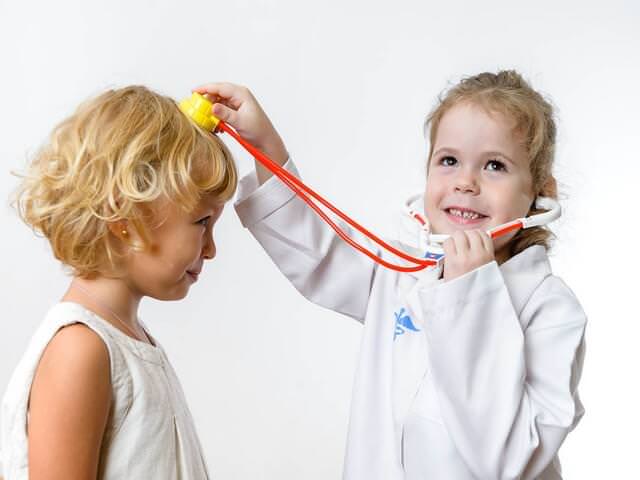
Terribly interesting
In this case, a visit to a medical institution is not planned: it is enough to take the pupils to the nurse’s office in the kindergarten itself. Many of them had already been there for inspection.
Draw the attention of preschoolers to medical paraphernalia: a white nurse’s coat, sterile instruments for examining patients, a work desk, a calendar. Explain the importance of being a doctor, but try to emphasize the idea of maintaining health instead of treating existing diseases. This way, the atmosphere of the doctor’s office will not look intimidating, but friendly.
The main idea of the lesson is to develop a patient and attentive attitude to health issues. Children need to be made to understand that taking care of their health is part of their daily routine.
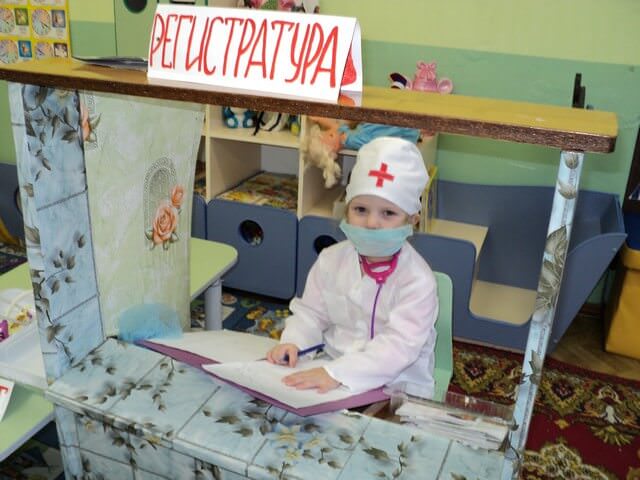
Say “ah-ah”, patient!
The scene itself can represent, for example, a medical examination. A group of children are examined by a number of doctors to enroll in school. Roles for doctors: general practitioner, dentist, surgeon and ophthalmologist. Make sure your nurse or nurse is present. The assistant can record important information on the patient's chart and assist during the examination.
Another version of the plot is with a doll, since it is better to assign the role of the patient to an inanimate object. So a group of children can transform into a council of doctors specializing in a specific problem, say, cough. Participants can suggest ways to get rid of an unpleasant illness: complete rest, regularly drinking a herbal decoction, taking lozenges, etc. You can introduce the words “patient”, “complaints”, “hurts”.
We use "Mail"
With the transfer of a large part of correspondence to the virtual world, the plot-role-playing game “Mail” is gradually losing its relevance. However, it is considered classic for work in preparatory groups of kindergartens. She is interesting, again, because of her profession. The work of a postman is shrouded in a flair of romance in the eyes of children: while working, you can ride a bicycle and please people with good news.
Marshak’s poem “Mail” perfectly illustrates the work of the post office. You can supplement your reading by watching suitable cartoons. And if the district post office is located next to a kindergarten, do not be lazy to organize a group visit: boys and girls are already able to understand the purpose of the work of the receptionist and sorter.
Suitable supplies for the scene include envelopes of various sizes, postage stamps, glue, as well as cardboard boxes, adhesive tape and cards for parcel information. Stationery stores offer postage stamps, however, you can make one yourself from a simple stamp.
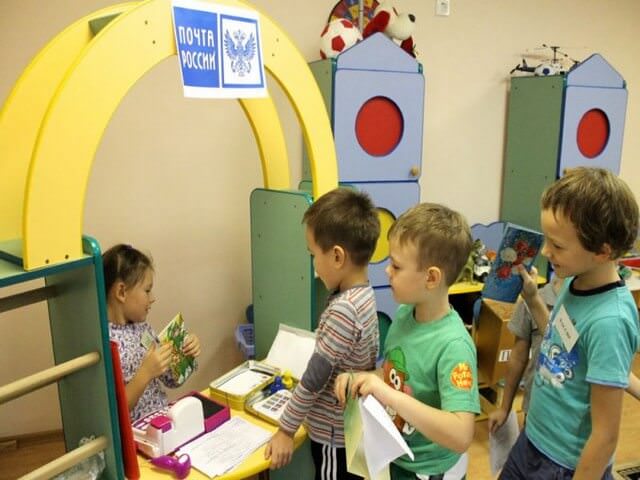
As they work, it is important for students to understand the idea of sorting letters and organizing their forwarding. Introduce them to the concept of index at a basic level.
Subjects for dramatization can be different: joint preparation of a letter for sending, removal of letters by postal workers on the instructions of the manager, sorting of printed materials by type: newspapers, magazines. The kids’ favorite plot twist is “The postman brought a parcel.” Delivery of a letter or parcel is accompanied by a greeting, clarification of the address, delivery of the parcel and a request for a signature. You can use a specially created mailbox with your own hands with the name and address indicated on it.
Let's play "Bank"
The “Bank” game also arouses great interest among preschoolers. What are banks used for? Where and how is money stored? What functions do cashiers, operators, managers perform?
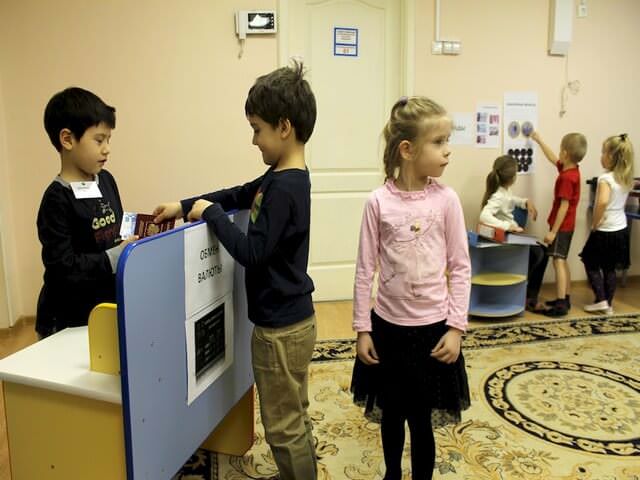
To prepare for the event, it is not necessary to take the entire preparatory group to the bank; it is enough to have a conversation and discuss the rules of the role-playing game. Focus on paraphernalia: computers, telephones, an imitation ATM, a huge variety of forms, pens and bank cards will be used. Money can be replaced with the corresponding pieces of paper from the board game "Monopoly". Roles can be distributed at will, as well as specific tasks to be solved. Someone is interested in how to get cash at the cash register, someone is interested in how to pay utility bills? The third participant's card got stuck in the ATM. Try to interest the guys and cover the whole range of banking operations that they understand.
The choice of suit is also important. To create a business atmosphere, choose ties, white shirts and typical matching scarves around your neck.
Scene "Barbershop"
The role-playing game “Barbershop” finds a warm response among girls in the preparatory group. Still would! Beauty salons offer a huge range of services to maintain beauty: manicure, pedicure, styling, massage, braiding. Some items from this list are favorite activities of the fair sex.

The event introduces participants to the professions of hairdresser, manicurist and pedicurist, cosmetologist, as well as administrator and cleaner.
To prepare for the game, it is important to acquire comfortable chairs and mirrors appropriate for each work station, as well as tools and materials. For a hairdresser, this will be a small table with combs of various sizes, curlers, a hairdryer, a plate and brush for coloring hair, a towel and shampoo. Of course, you can't do without scissors!
Pay attention to the safety of the hairdresser’s “workplace”: the tools must be suitable for children. It would be better if the scissors were toy ones.
To work as a manicurist and pedicurist, you will need a comfortable table that will allow the client and the master to sit opposite each other. On it you can place nail polishes of various colors, a special nail tray and creams.
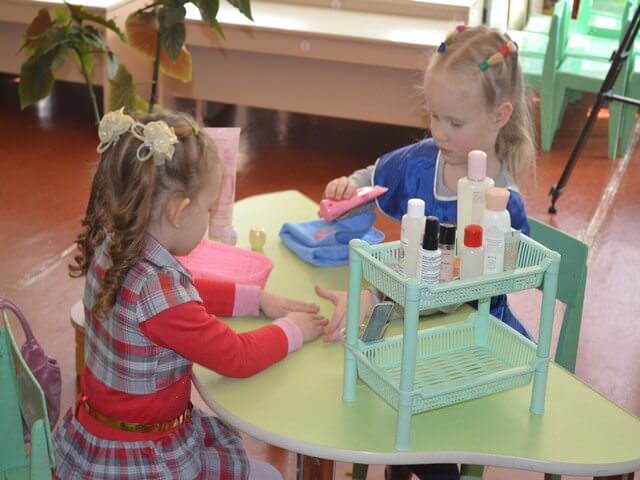
Participants can be divided into clients, administrative staff and craftsmen themselves. Together they can create a price list. Then, depending on the role, everyone learns the basic words: “hair length”, “parting”, “style”, “haircut”, “shaving”, “nail shape”, etc.
Administrator is one of the key roles. He meets the client, invites him to wait for the master over a cup of coffee or tea, and look at a fashion magazine. After the procedure is completed, the client goes to the administrator and pays for the procedure at the cash desk.
Thematic role-playing games - Thematic role-playing game “Beauty Salon” for children of senior preschool age
Publication “Role-playing game “Beauty Salon” for senior preschool children...” Goal: to develop in children the ability to play the role-playing game “Beauty Salon” Objectives: • Expand and deepen children’s knowledge and ideas about the professions of hairdresser, manicurist, makeup artist , SPA massage therapist, eyebrow administrator, cashier: • Learn acquired knowledge, reflect in…
Thematic role-playing game as a means of developing the creative imagination of children of senior preschool age. The general motive of the plot-role-playing game is the child’s desire for a joint social life with adults. But, on the one hand, the child is not yet ready to fulfill this desire, and, on the other hand, his independence is growing more and more. Role-playing games help resolve this...
Synopsis of the plot-role-playing game “Journey to the Mysterious Island” for children of senior preschool age Synopsis of the plot-role-playing game “Journey to the Mysterious Island” Relevance of conducting plot-role-playing games. Role-playing games allow you to develop children's creative abilities and their imagination. In the game, children learn to get used to the image of a particular character, to play a certain...
Outline of a role-playing game with children of senior preschool age with mental retardation and disabilities. “Supermarket” Plan of a role-playing game with children of senior preschool age with mental retardation and disabilities. “Supermarket” Methodological situation: children 5-7 years old Objectives: Correctional and educational: - enriching social and play experience between children; — formation of leading activities;…
Let's play "Theater"
A new theme for classes - theatrical life - introduces children to the profession of an actor, director, screenwriter, and also reinforces the basic ideas about the course of performances. The plot-role-playing game “theater” may be familiar to most pupils of the preparatory group of kindergarten: starting from 2-3 years old, children already attend the first puppet productions created for the youngest spectators. This is how children gain basic knowledge that there is a stage, a ticket and an intermission.
However, it is important to tell class participants about the rules of behavior in the theater: about purchasing a ticket, about maintaining silence while watching a production, and about possible actions during intermission. Among the new professions for children are cloakroom attendant, bartender, and organizer of order in the hall. On the other side of the curtains, the choice of crafts is even wider. To organize a performance, it is necessary to light the stage, conduct sound, and prepare costumes. The role of the presenter, who introduces the artists and the play, is also important.
Prepare theatrical paraphernalia: a curtain, one strong lamp, a microphone, chic costumes for the actors. Guests in the hall should be dressed appropriately: for the surroundings you can offer fans, feathers, binoculars and programs.
The distribution of roles will occur naturally: children prone to public speaking will choose the profession of an artist, and more shy boys and girls will choose a place “backstage” or in the auditorium. At the same time, what is important is not the production itself on a fictitious stage, but the coordinated work of all participants.
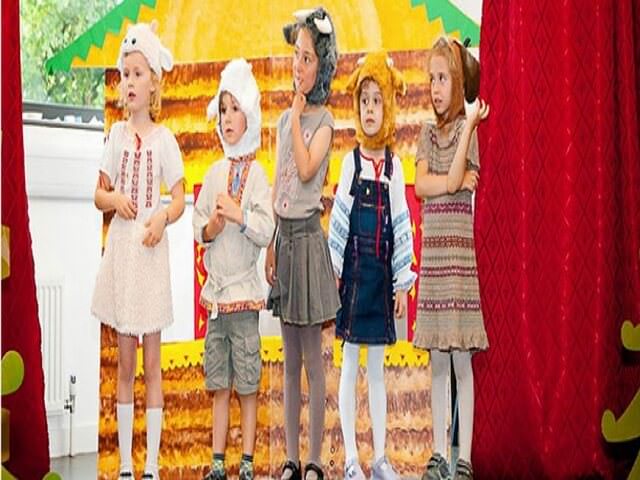
Card index of role-playing games (preparatory group)
The main content of the play of children in the preparatory group of kindergarten is a reflection of the relationships and interactions of adults with each other. The themes of the games can be varied. It is determined not only by the direct, but also by the indirect experience of children. All role-playing games are collaborative and collective in nature. Associations into subgroups are stable. They are built either on children’s interest in the same games, or on the basis of personal sympathies and affections. Plot-based role-playing games of the same content are not only repeated for a long time, but also develop, become enriched, and exist for a long time. In the play of a child of this age, the preparatory stage is clearly distinguished: the distribution of roles, the selection of playing materials, as well as the making of homemade toys together with the teacher. The number of people involved in the game increases to 5-7 people. Children of the preparatory group have higher demands on the quality of performance of individual roles, which often gives rise to children's dissatisfaction with each other and leads to conflicts, for example: children refuse to accept into the game a child who performs the role poorly, constant contenders for the main roles appear. Stable play groups also emerge. But at the same time, the formation of closed groups is possible, the participants of which are reluctant to accept “outsiders” into the game; an example is the separation of boys and girls in the game. In such cases, it is necessary for the teacher to directly influence the children’s games: by participating in the children’s collusion before the game or talking about the past game, the teacher can evaluate the behavior of the players: condemn the manifestation of harshness, selfishness, encourage mutual assistance, praise for an interesting invention, suggest a new fascinating detail. Conversations between the teacher and children should be short and lively. They require the teacher to be able to understand the game plan and comprehend the nature of the role-playing and friendly relationships of the players. Participating in the children’s agreement about the upcoming game, the teacher should direct their attention to the selection of basic play equipment, provide assistance in making the missing equipment, teach them basic game planning, and independent organization of the play environment. As the game progresses, the teacher can give children advice, ask questions, drawing the attention of the players to one side or another of the game, etc. In the preparatory group, the teacher rarely takes on one role or another. I selected role-playing games from various sources and created a small card index that is convenient to use in my work.
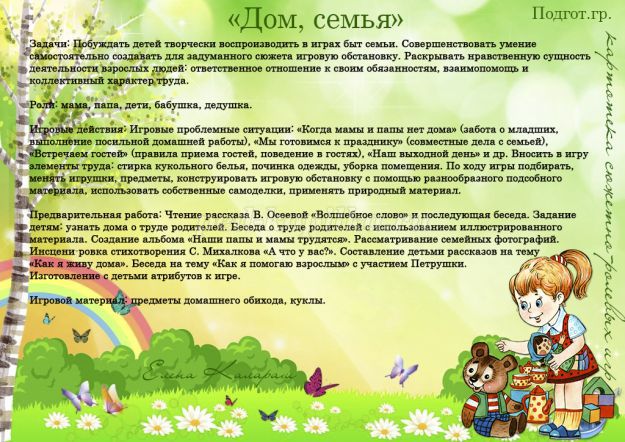
We recommend watching:
Game program for children of the preparatory group of kindergarten Didactic game for speech development for children of the preparatory group Ball games for children of the preparatory group of kindergarten Didactic manual for speech development of children 5-7 years old
Similar articles:
How to choose a driver among children
Outdoor games for preschool children
Meeting with future first-graders. Scenario
Labyrinths for children 6-7 years old
Play activities for children of senior preschool age (6-7 years old)
Role-playing game "Family"
The chosen plot serves to consolidate knowledge about family ties within the family and the characteristics of relationships between close people. Each pupil of the preparatory group has already formed his own idea of the family, to which the plot-role-playing game should come closer or at least not contradict it. The main ideas behind this idea are to remind about trust, love and understanding in the family, and to show by a neutral example the responsibilities of each family member. It is important to give the concept of mutual assistance and care for loved ones.
Educators often resort to splitting the plot into 3-4 stories. Examples of sketches on the topic “family” are given below.
- Morning, the whole family gathers in the kitchen, mom prepares breakfast, daughter and son help set the table, dad prepares coffee. At the table, the family has a leisurely conversation about plans for the day. After breakfast, each family member cleans up after himself.
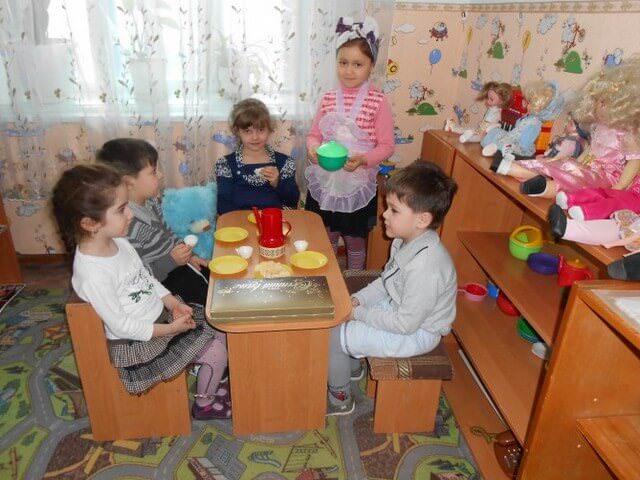
- Weekend. The whole family slowly gets ready for a walk in the park.
- Cleaning the house. Each family member does some kind of housework: vacuuming, washing the floor, windows, dishes, watering flowers or wiping dust.
- Preparing for a family holiday. The house is getting ready to receive guests. Mom and daughter are setting the table, grandmother is baking pies.
The tools for this game should be taken “from life”, that is, everything that surrounds children at home will be used: a sofa, a TV, kitchen utensils, a table and chairs, as well as household appliances.
If there are more than 5 people in the group, be imaginative about “kinship ties”: aunts, uncles, great-aunts and uncles, nephews, neighbors and godmothers can also play a role and fit perfectly into the home environment. Don’t forget about pets; perhaps among the kindergarten students there will be young talents who can imitate the bark of a dog or the meow of a cat.
Card index of role-playing games for children of the preparatory group
Equipment:
all the toys you need to play in kindergarten.
Game roles:
teacher, junior teacher, housekeeper, cook, janitor, manager, senior teacher, nurse, speech therapist, music director, physical instructor, choreographer, caretaker, plumber, electrician, educational psychologist, students.
Preliminary work
: conversation-game “Our Favorite Kindergarten”, examination of the album “Who Works in the Kindergarten”, presentation “Our Kindergarten”, tour of the kindergarten.
Story-based role-playing game “Beauty Salon”
Target:
creating conditions for expanding children’s ideas about the profession of a hairdresser, the ability to negotiate and distribute roles.
Equipment:
robe for the hairdresser, cape for the client, hairdresser's tools - comb, scissors, bottles of cologne, varnish, hair dryer, hairpins, albums with hairstyles, coloring palette, wigs, curlers, accessories for hair coloring, elastic bands, etc. , children's cosmetics.
Game roles:
hairdresser, client, administrator, makeup artist.
Preliminary work
: conversation-game “Hairdresser”, looking at the album “Fashionable Hairstyles -2020”, drawing with modeling elements “Stylish Hairstyle”, creating an album “Beautiful Hairstyles”.
Plot-role-playing
game “Journey through the forest”
Goal:
creating conditions for fixing the names of various types of plants, seeds, and mushrooms. Fostering interest and love for nature.
Equipment:
collections of flowers, leaves, seeds, mushrooms. Drawings of tree trunks. Costumes for children. Cardboard key. Treat.
Preliminary work:
excursion to the forest. Making costumes for the game together with parents. Learning forest dances. Exhibition of collections of seeds, leaves, flowers, mushrooms. Preparing games and attractions for the forest carnival.
Game roles:
owners of forest edges, guests of the forest.
Plot-role-playing
game “Journey along the Abakan River”
Purpose:
creating conditions for the development of children’s ability to implement and enrich the plot of the game. Expanding ideas about the types of river transport, about the importance of the work of adults - river port workers for the cities and villages of the country.
Equipment:
building material, plasticine, cardboard and other materials; attributes for the game: vests, captain's cap, steering wheel, compass, anchor, lifebuoy.
Preliminary work: uh
excursion to the port. Conversation about the port using illustrative material. Reading excerpts from F. Lev’s book “We are sailing on a self-propelled gun.” Construction of berths and ships from building materials. Drawing of various ships. Production of a schematic map of the Abakan River. Modeling gifts to send to other cities. Preparation of an exhibition of drawings. Examination of the painting “Navy”. Making game attributes together with the teacher. Watching films and fragments on the theme “At the Port”. Multimedia presentation “Abakan River”, reading of the Khakass legend about the Abakan River, poetry.
Going to a cafe
The idea of developing dialogue according to a template or a pre-known scenario is perfectly reflected in the “cafe” scenes. Many students in the preparatory group are 4-5 years old, which means that the role-playing game “cafe” will not be new to them. Modern babies are accustomed to accompanying their parents in public places from the cradle.
The purpose of the lesson is to form in children an idea of working in a cafe, to explain the basic rules of behavior in such places and etiquette standards appropriate to their age.
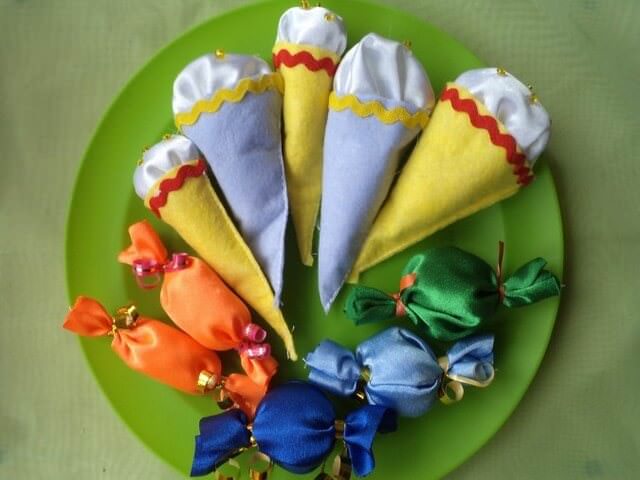
The guys should be familiar with the professions associated with restaurants and cafes: waiters, bartenders, cooks, cleaners and administrators. You can use all of the listed characters in the scene and add clients.
A serious approach will be required to the materials and creation of the surroundings: tables and chairs, a bar counter, a cash register, a telephone, a reception desk, a kitchen with appropriate equipment, food and drinks (you can use toys), as well as professional uniforms: aprons, hats and signs.
During the game itself, it is important to follow the chain:
- entrance to the cafe;
- greetings;
- table selection;
- familiarization with the menu;
- menu discussion;
- order to the waiter.
Further events can develop in parallel in two subgroups: one continues to wait for the order, the other takes on preparing it. After a snack you should:

- thank and praise the meal, and if possible, meet the chef and pay a compliment in person;
- ask the waiter for the bill;
- to pay off;
- say goodbye and leave the establishment.
Each point can be accompanied by 2-3 replicas. It is important to treat the waiter on a first-name basis and behave with restraint so as not to disturb other visitors to the cafe.
You can be very imaginative when creating a menu, for example, dividing it into main parts: “Drinks”, “Desserts”, etc. You can pay for your order, as in the case of “Bank”, with a bank card or “cash” from the game “Monopoly”.
Role-playing game "Cafe"
Children:
Let's try to work!
Vos-l:
Tell me, what professions do people work in the cafe?
Children
: administrator, waiter, cashier, cook, cook, security guard, cleaner.
The teacher takes on the role of cafe administrator.
Vos-l:
— What should a cook do in a cafe?
Children:
Cooking, boiling, frying.
Vos-l:
— What is the cashier responsible for?
Children:
He takes money from visitors and gives change.
Vos-l:
— What are the responsibilities of a waiter?
Children:
Politely take orders, bring food, serve tables.
Vos-l: —
What does a cleaning lady do?
Children:
Cleans floors and collects trash.
Vos-l:
Organizers of holidays can also work in cafes, entertaining visitors, playing with them, and organizing various competitions.
Let's decide who will be who in our cafe. We need to distribute roles. For the first time, I will also play with you and take on the role of a cafe administrator. This is a person who greets visitors, seats them at tables and makes sure that they feel comfortable and happy.
Distribution of roles.
Well, it's time for us to go to the cafe.
Vos-l:
guys, every cafe should have a name. Our cafe also has a name, but it is encrypted and we need to unravel it.
Children put together a word from letters, solving the puzzle, and get the word “Friendship”
Voss: And
So, now our cafe is called “Friendship”
Creating a gaming environment.
Children wear overalls and suits.
Visitors take money, wallets, handbags, and go out the door.
Customers enter the cafe.
Administrator
: -We are glad to welcome you to our cafe “Friendship”. Come in, choose a table, place your orders.
The children are seated at the tables. The waiters hand out menus. Visitors read the menu and choose products.
Visitors place orders:
A musical signal sounds.
Administrator:
Today you are greeted by a mischievous presenter - Yagodka.
It turns out, Berry, she is dressed in a bright-colored suit,
- Hello children! I know that you are all smart and resourceful! I invite you to take part in the “Guess the Riddle” competition and win a prize!
Yagodka reads riddles and awards prizes for correct answers.
A beautiful maiden sits in a dungeon, And her braid is on the street. (Carrot)
Angry touchy lives in the wilderness of the forest. There are a lot of needles, but not one thread. (Hedgehog)
They live across the street, but don’t see each other (Eyes) Administrator
-And now a surprise for visitors: a musical moment. Two musicians come out and play musical instruments, the children sing along. The music "Friendship" is playing.
Our next competition is “Sports”.
-Who can name more types of sports?
Children take turns naming sports. The winner receives a prize.
Administrator
-This is where our entertainment program ends. Our first day of work is also coming to an end. Dear visitors, do not forget to pay for your orders.
